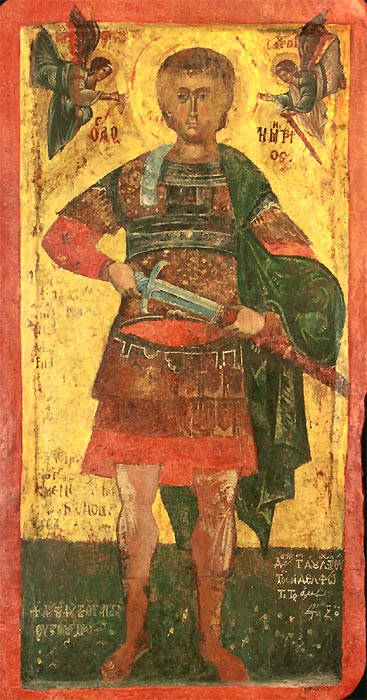On October 26, the Bulgarian Orthodox Church marks the feast day of Saint Demetrius of Thessaloniki. The martyr is sometimes called “protector of Balkans” and is widely revered by Greeks, Bulgarians, Serbs and Russians.
 Born in the 3rd century in the city of Thessaloniki, after the death of his father Dimitar became mayor, accepted the Christian faith and taught the citizens of Thessaloniki not to worship idols, but to open their hearts to Christ. Roman emperor Maximian ordered him imprisoned. Even imprisoned, St. Dimitar continued to preach and was killed. After time, his relics we discovered by accident and they had healing power and radiated pleasant aroma.
Born in the 3rd century in the city of Thessaloniki, after the death of his father Dimitar became mayor, accepted the Christian faith and taught the citizens of Thessaloniki not to worship idols, but to open their hearts to Christ. Roman emperor Maximian ordered him imprisoned. Even imprisoned, St. Dimitar continued to preach and was killed. After time, his relics we discovered by accident and they had healing power and radiated pleasant aroma.
"In the traditional folk calendar of the Bulgarians, Dimitrovden and Gergyovden /May 6/ frame the calendar and divide the year into two seasons: active and inactive," says Dr. Petko Hristov from the Institute of Ethnology and Folklore with Ethnographic Museum of the Bulgarian Academy of Sciences in an interview with Radio Bulgaria. "For Bulgarians and their year-round work Dimitrovden is a holiday of special importance. On St. George's Day in the spring the herds were brought high in the mountains and on Dimitrovden they were brought back to the villages. The holidays are popular not only among Christians, but are also marked by Muslims in Bulgaria. According to popular ideas, St. George and St. Demetrius are twin brothers. That is why there are many icons on which St. George is riding a white horse and St. Dimitar is riding a red horse next to him. We can see such images on numerous icons that people used for prayer at home.”
Photo: nessebarinfo.com
On November 25, the Bulgarian Orthodox Church honours the memory of St. Clement of Ohrid – a distinguished archbishop, teacher and scholar. He was among the most prominent disciples of the brothers Cyril and Methodius, the Holy Seven Apostles – the..
On November 24, the Bulgarian Orthodox Church honors St. Catherine (Sveta Ekaterina in Bulgarian) , who was one of the most educated women of her time. She lived in the late 3rd and early 4th centuries and came from a noble family in Alexandria...
The Patriarchal Cathedral of St Alexander Nevsky is celebrating its temple feast today. The cathedral, a symbol of the Bulgarian capital, was built "in gratitude to the Russian people for the liberation of Bulgaria from Ottoman rule in 1878". Who..
In anticipation of the Nativity of Christ, the Orthodox Church opens its doors for today's divine services, heralding the fulfillment of the mystery of..
The first modern Christmas was celebrated in Bulgaria in 1879. It followed a European model with a Christmas tree, ice skating and gifts. At that..
His Holiness Daniil, Patriarch of Bulgaria and Metropolitan of Sofia, addressed the Orthodox Christians on the eve of the bright Nativity of Christ..

+359 2 9336 661
